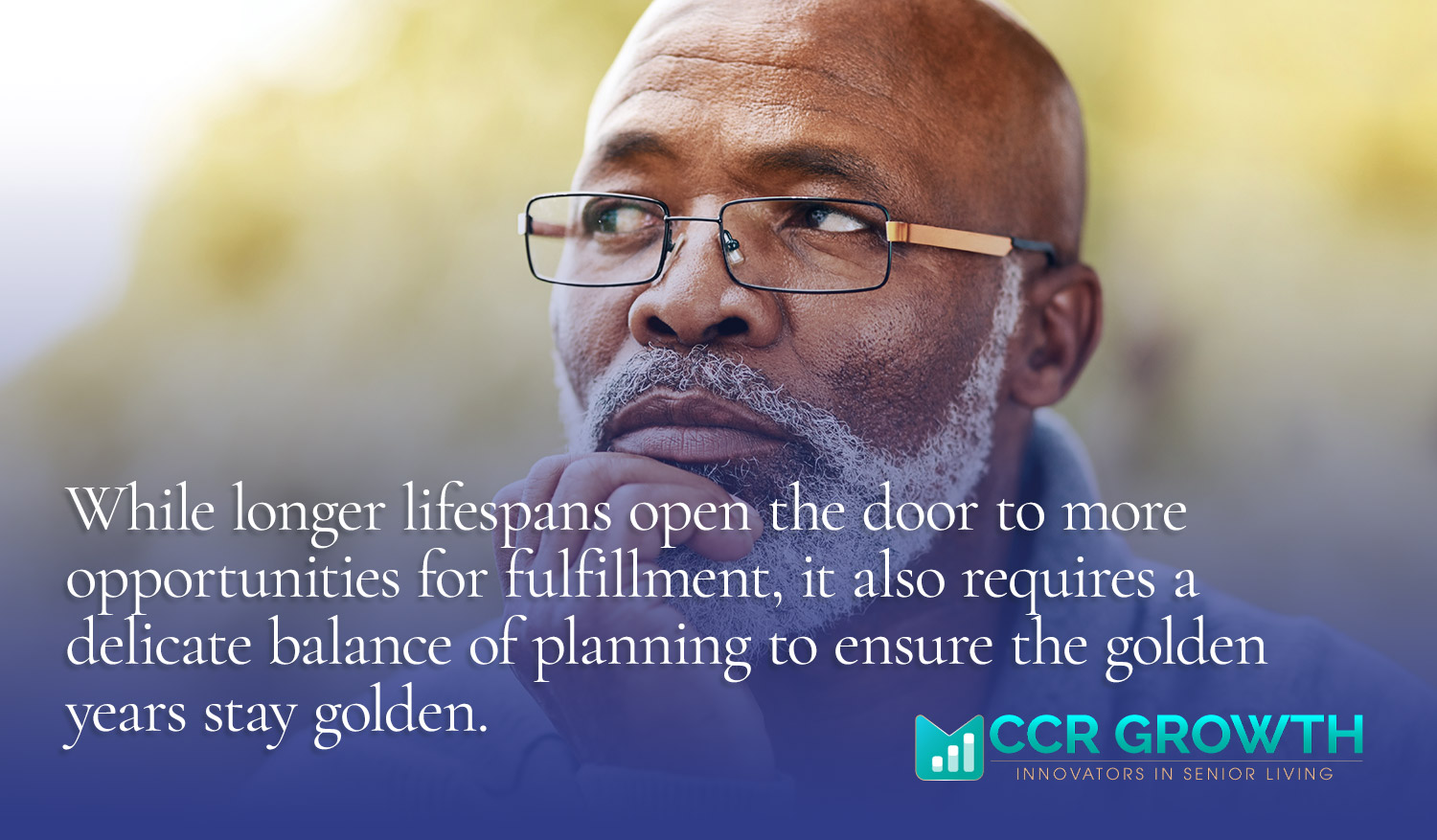
Embracing Extended Golden Years: Addressing Long-Term Care in an Age of Increasing Senior Longevity
With human beings enjoying longer lifespans than ever before, the Baby Boomer generation has witnessed a remarkable extension in life expectancy compared to previous generations. However, this longevity presents a dual challenge and opportunity for individuals and the senior living industry. Maintaining a high quality of life becomes paramount as people age, necessitating strategies to address common challenges such as social isolation, health issues, and maintaining physical and cognitive activity. For Continuing Care Retirement Communities (CCRCs), also known as Life Plan communities, this underscores the need to adapt services and offerings to support residents’ evolving needs while fostering independence and well-being. Now, more than ever, collaboration with seasoned sales and marketing experts is crucial. By leveraging their expertise, CCRCs can effectively communicate their value proposition, attract the right audience, and ultimately enhance the lives of their residents.
The Impact of Longer Lifespans

Longer lifespans bring about many possibilities, including more time for leisure, family engagement, and personal fulfillment. However, they also present unique challenges, particularly for seniors transitioning into long-term retirement. Many older adults desire to maintain active and involved lifestyles while enjoying retirement’s comforts. This delicate balance requires tailored solutions from retirement communities.
Social Isolation
One significant aspect of longer lifespans is the prevalence of solitary living and loneliness among older adults. As individuals age, they may experience changes in their social networks, such as the loss of friends or family members, retirement from work, or physical limitations that restrict their mobility and social engagement. This social isolation can have detrimental effects on their mental and emotional health, leading to feelings of loneliness, depression, and anxiety.
Research has shown that chronic loneliness is associated with an increased risk of various health conditions, including heart disease, stroke, cognitive decline, and premature mortality.
To address the challenge of social isolation and loneliness among older adults, CCRCs are reimagining their community offerings and activities to promote social connection and engagement.
CCRCs can create supportive environments where residents feel valued, connected, and supported by fostering a sense of belonging and camaraderie. This may involve organizing social events, group activities, and recreational programs encouraging residents to interact, collaborate, and build meaningful relationships with their peers. From book clubs and hobby groups to fitness classes and cultural outings, CCRCs are expanding their activity calendars to offer a diverse range of opportunities for socialization and connection.
Adapting Activities for Safety
In addition to addressing social isolation, CCRCs are also adapting their existing activities and amenities to ensure the safety and well-being of residents. As individuals age, they may experience changes in their physical abilities and sensory perception, increasing their risk of accidents and injuries. To mitigate these risks, CCRCs are implementing proactive measures such as fall prevention programs, mobility aids, and environmental modifications to create safe and accessible living spaces for residents. By prioritizing resident safety and well-being, CCRCs can provide peace of mind to residents and their families, enabling them to confidently enjoy an active and independent lifestyle.
Preventing and Delaying Cognitive Decline
Moreover, the benefits of participating in social activities and engaging in meaningful pursuits extend far beyond reducing loneliness and enhancing safety. Research has shown that staying socially active and mentally stimulated can improve cognitive function, boost mood, and promote overall well-being in older adults. By encouraging residents to participate in group activities, volunteer opportunities, and lifelong learning programs, CCRCs can empower them to lead fulfilling and purposeful lives in their later years. From stimulating intellectual discussions to fostering creative expression and personal growth, CCRCs play a vital role in promoting holistic wellness and vitality among older adults.
The Benefits of Physical Activity

A recent University of Cambridge study examined activity levels among 1,433 participants aged 60 and above using accelerometers. The study found that a reduction in physical activity and increased sedentary behavior were linked to lower quality of life scores among older adults. These findings highlight the importance of maintaining physical activity levels in later life.
Moderate-intensity physical activity that raises the heart rate is known to reduce the risk of a number of diseases, including heart disease, stroke, diabetes, and cancer. Recommendations from the UK’s NHS suggest that adults do at least 150 minutes of moderate-intensity activity or 75 minutes of vigorous-intensity activity a week. Breaking up prolonged periods of sedentary behavior with light activity or standing is also recommended for older adults.
The study offers valuable insights into how seniors can maintain their quality of life through physical activity. Researchers recommend incorporating brisk daily walks, gardening, bicycling, dancing, and tennis into one’s routine. These activities promote physical health and contribute to mental well-being and social engagement.
Adapting CCRC Services

By addressing the challenges that come with expanding lifespans, and by using the constant flow of new information around well-being in later years, CCRCs can create vibrant communities where residents can thrive and flourish in their later years. Through a commitment to innovation, inclusivity, and person-centered care, CCRCs can continue to lead the way in supporting healthy aging and enhancing the quality of life for older adults across the globe.
Here are some of the things that forward-thinking CCRCs are doing to adapt their offerings:
Expanded Wellness Programs
- Introduce tailored wellness programs for older adults, like fitness classes and nutrition workshops.
- Include holistic approaches such as yoga and mindfulness to boost physical and mental well-being.
- Partner with local healthcare providers for on-site screenings and preventive care.
Technology Integration
- Use smart home tech and telehealth services to improve connectivity and accessibility.
- Offer online learning resources and digital libraries for residents.
- Create apps for easy access to community events and services.
Environmental Design
- Build outdoor spaces and community gardens to encourage activity and nature connection.
- Ensure facilities are accessible for all with universal design principles.
- Design common areas for socialization and meaningful relationships.
Lifelong Learning Initiatives
- Provide workshops, lectures, and cultural events for intellectual growth.
- Partner with educational institutions for continued learning opportunities.
- Cultivate a culture of curiosity and learning within the community.
Personalized Care and Support
- Prioritize person-centered care plans based on residents’ needs and preferences.
- Train staff to provide compassionate care and foster a supportive environment.
- Implement innovative care models for comprehensive support.
By embracing progressive strategies and initiatives, CCRCs can continue to lead the way in senior living innovation, empowering residents to live fulfilling lives and thrive in their later years. Through a commitment to active living, holistic care, and continuous improvement, CCRCs can create vibrant communities where older adults can flourish and age with grace and dignity.
Wrap-Up
The evolving landscape of senior living demands innovative solutions and collaborative partnerships to meet the changing needs of older adults. By working closely with sales and marketing experts like CCR Growth, CCRCs can confidently navigate these challenges, ensuring that their communities remain vibrant, engaging, and supportive environments for residents to thrive in their later years. Together, we can empower CCRCs to create meaningful experiences, foster strong connections, and enrich the lives of older adults nationwide.





